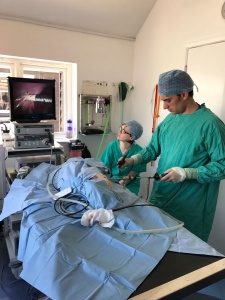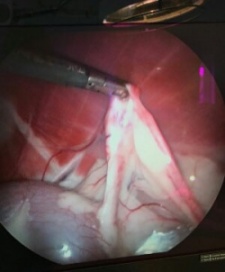This operation involves removal of the entire uterus (womb) and ovaries via a midline incision into the dog’s abdomen.
Our advice is breed dependant., for small breeds and bitches who will be under 15kgs body weight once they are fully grown, we recommend neutering at 6 months old before their first season. For bitches over 15kgs body weight when fully grown we recommend waiting until fully grown - this could be 12 - 18 months. For further advice please speak to one of our vets or nurses
Your dog will be admitted as a ‘day patient’ and following a pre-operative check by your veterinary surgeon, she will be given a pre-medication and analgesic (pain killing) injection prior to her general anaesthetic. After surgery and following her recovery from the anaesthetic she will be ready to go home later the same day. You will be given full discharge instructions on how best to care for your dog after surgery and she will be checked by your veterinary nurse 3 days later to ensure the wound is healing. If there are any sutures present these will be removed 10 days later. We usually use intradermal (under the skin) sutures for our bitch spays, so there are no skin sutures requiring removal or to aggravate your dog while their wound is healing. Your dog will go home with some pain relief medication for a few days as well as a Buster collar to prevent any interfering with their wound. While the operation is more complicated than castration, it is still a routine procedure and their recovery is usually fairly quick.
What are the advantages?
- Your dog will not have seasons and therefore cannot become pregnant.
- Removal of their uterus and ovaries reduces the chances of infection in later life.
- If your dog is spayed the incidence of mammary (breast) cancer is greatly reduced.
- False (phantom) pregnancies are stopped.
- Vaginal polyps (small nodules) are prevented.
- Mismatings and unwanted puppies are avoided.
Are there any disadvantages?
Any surgical procedure involving general anaesthesia carries a small risk. As with castration, your dog will be assessed prior to surgery to ensure she is fit and well and full instructions will be given when she goes home to minimise potential problems.
A small proportion of larger breeds can develop urinary incontinence, which may require treatment later in life.
Minor coat changes may be noticeable in certain breeds such as Irish Setters.
It is a common fallacy that a neutered dog will become fat and lazy. They may have a decreased activity level following neutering, which in turn causes weight gain IF your dog continues to be fed the same amount of food as before they were neutered. Neutered pets can require up to a 30% reduction in their feeding requirements. This is due to no longer utilising energy in to reproduction.This extra energy may then be stored as excess body fat instead.
After your dog is neutered, we recommend moving her onto a neutered dog food. Royal Canin have developed a competitively priced, veterinary exclusive pet food, Royal Canin range. This is high in protein and low in fat to help combat against any weight gain. Your veterinary nurse will be able to advise you on the best feeding regime for your dog.
When to spay?
Bitches can be spayed from six months of age so prior to their first season. If they have had seasons then ideally three months after the end of their last season i.e. in-between seasons. The younger she is the greater the benefit from surgery.
Are there any alternatives?
Cinque Ports Vets are pleased to be able to offer our clients the option of keyhole (laparoscopic) surgery for routine bitch spays and other procedures where appropriate.

Keyhole spay involves the introduction of a camera and specialised instruments into the abdomen through two or three small incisions. Many of the traditional surgical procedures such as spaying can be now performed laparoscopically. Traditional surgery involves the removal of the ovaries and uterus (ovariohysterectomy) but laparoscopically generally only the ovaries are removed (ovariectomy).
The tissues are visualised under high magnification and blood vessels are cut and sealed using specialist equipment.
It is well established in human surgery that laparoscopic procedures provides quicker healing time and less post-operative complications than other methods. This is proven also in modern veterinary medicine.
The benefits of laparoscopy for our pets are similar and aim for a faster and more comfortable return to normal activity. One typical example is the young, very active bitch that is not likely to accept easily periods of complete rest from exercise post neutering.

After Keyhole surgery dogs will still need to be kept on the lead but the risk of damaging the surgical wounds (because of the small size) is greatly decreased. Please be aware that we do need to shave a little more fur than with a traditional procedure and Keyhole surgery is a little more expensive due to the cost of the equipment required and the expertise.
Useful links:
www.royalcanin.co.uk




